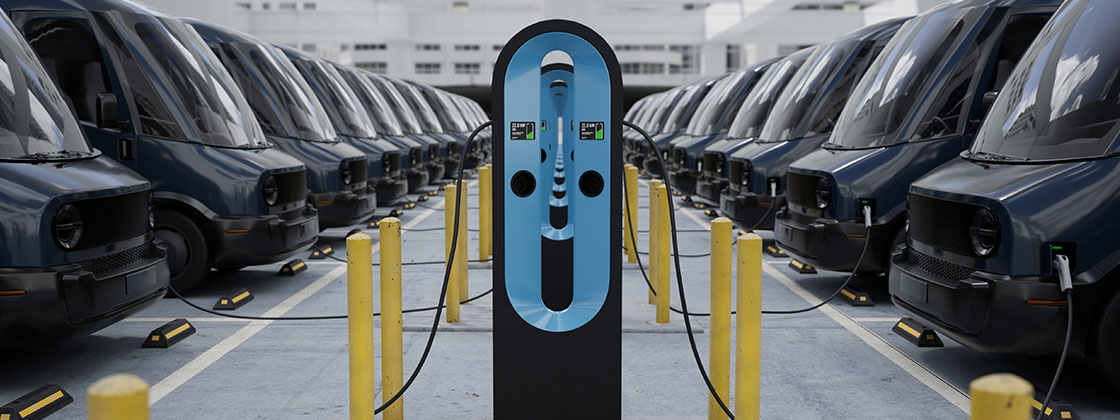Which type of electric vehicle is best suited for your fleet?
January 30, 2025
4 minutes

As we settle into 2025, companies find themselves increasingly motivated to reduce carbon emissions within their fleet. From external forces such as government carbon reduction mandates to internal sustainability targets, all signs point towards reducing your fleet’s carbon footprint.
The good news for fleet leaders is that developments such as falling EV prices, improved battery technology, longer driving ranges and increased charging locations have made EVs both an attractive and viable option. These advancements are not only enhancing performance but also reducing the total cost of ownership.
Of course, not all EVs are created equal. There are different types of EVs, each with their own distinct advantages.
What are the three types of electric vehicles?
Electric vehicles can generally be broken down into three main categories:
- Hybrid electric vehicle (HEV)
- Plug-in hybrid electric vehicles (PHEV)
- Battery electric vehicles (BEV)

Illustration of different hybrid and electric vehicles and their energy source
Types of EVs and their fleet use cases
Hybrid electric vehicles (HEV)
HEVs offer a practical transition for fleets not yet ready to fully commit to electric power. They combine an internal combustion engine and an electric vehicle drivetrain. This drivetrain allows the vehicle to achieve significantly better fuel economy. However, an HEV does not require an external power source to recharge the battery. Instead, recharging of the on-board battery is done through regeneration, including regenerative braking.
HEVs are not commonly considered to be a Zero Emissions Vehicle (ZEV) by climate organizations or government agencies since they rely on the internal combustion engine to recharge the battery. Only a portion of the vehicle's total drive time is under battery power.
Fleet use case: HEVs can be a solution for drivers without access to an external power source for recharging of the vehicle's battery although they do not reduce carbon emissions to the same degree as PHEVs and BEVs.
Plug-in hybrid electric vehicles (PHEV)
PHEVs have a hybrid engine that uses both an electric motor and a gas engine and can be powered by both a battery and fuel. The battery can be recharged through an electrical power source and the vehicle's tank can be refilled with fuel. The battery can typically last for around 50 kilometers, after which the engine requires gasoline or diesel to continue.
The battery in a PHEV can be plugged in to a power source to be charged and, in some cases, can be recharged through regenerative braking. PHEVs are commonly considered a ZEV by many climate organizations and government agencies as they can be recharged without relying on an internal combustion engine and can travel short distances relying solely on electrical power.
Fleet use case: PHEVs are ideal for fleet drivers who typically travel less than 50 kilometers (31 miles) a day but on occasion travel longer ranges.
Battery electric vehicles (BEV)
BEVs, also referred to simply as electric vehicles, have motors that are solely powered by rechargeable batteries with no internal combustion engine, and are considered the most sustainable vehicle option for reducing fleet emissions.
The batteries for these vehicles are recharged through an external electrical power source. The driving range for EVs can vary from 200 kilometers (125 miles) per charge up to more than 500 kilometers (310 miles) per charge, depending on the specific model of the BEV. They are considered a ZEV by most climate organizations and government agencies as they do not produce tailpipe emissions.
Fleet use case: BEVs are the best choice when it comes to reducing fleet-related tailpipe emissions. These vehicles often require the installation of specific charging capabilities at the residence or workplaces of each driver to facilitate charging of the vehicle.
Best for: Sales fleets (sedans) and some service fleets (light trucks and vans).
HEV, PHEV and BEV comparison chart
|
|
Hybrid Electric Vehicles (HEV) |
Plug-In Hybrid Electric Vehicles (PHEV) |
Battery Electric Vehicles (BEV) |
|
Energy source |
Gasoline fuel pump |
Charging power station |
Charging power station |
|
Range |
Good range |
Excellent range |
Range limitations depending on model |
|
Environmental impact |
Lower tailpipe emissions compared to ICE* |
Lower tailpipe emissions compared to ICE* |
Zero tailpipe emissions |
|
Operating costs |
Maintenance and fuel costs similar to ICE |
Maintenance and fuel costs similar to ICE
|
Lower operating cost compared to ICE** |
*ICE: Internal Combustion Engine
** Depending on vehicle class and use case
Ready to learn more?
Determining what type of electric vehicle is best suited to your specific needs and business goals can seem daunting. But it doesn’t have to be.
Our life cycle cost analysis (LCCA) breaks down costs such as charging, infrastructure, fuel and battery capacity. We will look at the number of units in your fleet and help you figure out which types would be a good match for your fleet.
Get in touch with us to learn how Element can complement your electric vehicle strategy.
Never miss an update
Subscribe for more news and thought leadership from Element.


